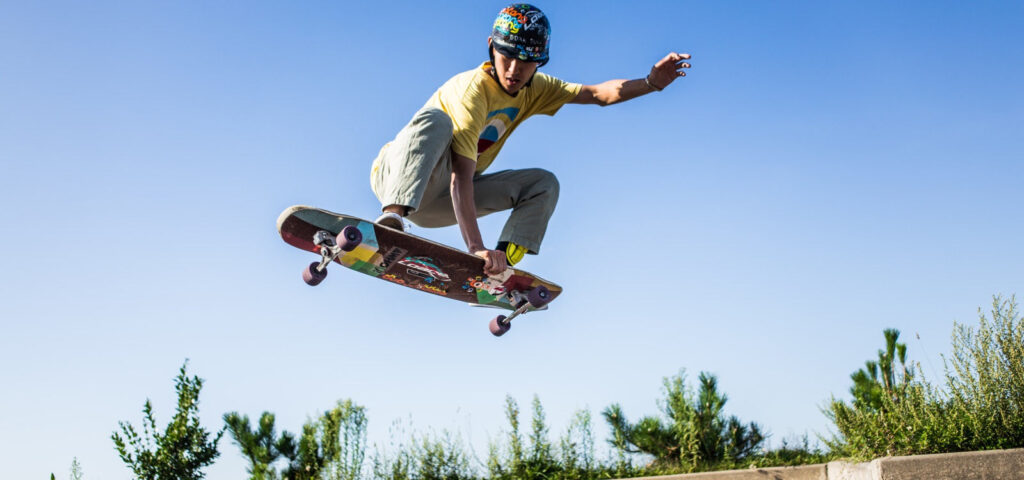To put trucks on a longboard, first, drill holes in the deck for the truck bolts, and then attach the trucks to the deck using the bolts, nuts and a wrench. Longboarding is a fun and thrilling activity that involves riding a board similar to a skateboard but with longer and wider dimensions.
To enhance a longboard’s performance and stability, trucks need to be properly installed. Installing trucks is crucial since it determines how the board will turn, glide and operate. With the appropriate tools, installing trucks to a longboard deck is relatively easy. In this article, we’ll go through the necessary steps on how to put trucks on a longboard. By following the guidelines provided, you can install trucks on your longboard and enjoy your ride while ensuring safety and stability.

Credit: stokedrideshop.com
Understanding Trucks
Trucks are an essential component of a longboard, determining the stability and maneuverability of the board. In this section, we will delve into the basics of understanding trucks for your longboard.
Components Of A Truck
Before we talk about the different types of trucks, let’s explore the various components of a truck:
- Hanger: the largest part of the truck that attaches to the baseplate and holds the axle in place
- Bushings: a urethane component that cushions the hanger against the baseplate and allows for truck turning
- Kingpin: a large bolt that goes through the middle of the bushings, holding the entire truck together
- Pivot cup: a small component that allows the hanger to pivot smoothly on the baseplate
Different Types Of Trucks
There are two primary types of trucks – traditional kingpin (tkp) and reverse kingpin (rkp) trucks.
Traditional Kingpin (Tkp) Trucks
- Usually used for street skating and tighter turns
- Shorter hanger length
- Taller bushings for maximum turnability
- Not ideal for higher speeds
Reverse Kingpin (Rkp) Trucks
- Typically used for cruising, carving, and downhill riding
- Longer hanger length
- Lower bushings for better stability at higher speeds
- Wider turning radius than tkp trucks
How To Choose The Right Trucks For Your Longboard
Choosing the right trucks for your longboard is crucial for a comfortable and stable ride.
- Determine the type of riding you will be doing (street, cruising, downhill)
- Consider the hanger width in relation to the deck width
- Choose appropriate bushing hardness for your weight and riding style
- Consider the height of the truck (lower trucks offer more stability)
- Think about the brand reputation and quality assurance
Understanding trucks is vital for all longboard riders. No matter your preference in riding style or discipline, selecting the right trucks will make all the difference in the stability and maneuverability of your longboard.
Preparing Your Longboard
Longboarding is an exciting activity that is enjoyed by many people worldwide. However, to have a safe and enjoyable ride, it’s vital to have the right longboard and truck set up. While there are different opinions on how to put trucks on a longboard, preparing your longboard for the installation process is crucial.
In this section, we’ll cover the essential steps you need to take to install new trucks on your longboard.
What Tools You Need
Before installing trucks on your longboard, you’ll need to gather the necessary tools to make the process easier.
- Wrench tool
- Screwdriver
- Skateboard hardware
- Sandpaper
- Cleaning solution
- Rags
- Old toothbrush
How To Remove Old Trucks (If Replacing)
Before installing new trucks, you’ll need to remove the old ones first. Removing old trucks requires a specific process, and if you’re a beginner, we recommend getting professional help.
- Remove the nuts and bolts from the trucks using a wrench tool
- Lift the truck off the board, and ensure that you hold onto the washer and the rubber bushing
- Use a screwdriver to remove any remaining bolts or screws on the deck
- Once you’ve removed the old trucks, clean the deck thoroughly using a cleaning solution and an old toothbrush
Proper Cleaning And Sanding For Installation
After removing the old trucks, you’ll need to clean and sand the deck thoroughly before installing the new trucks.
- Use a cleaning solution and a rag to clean the deck’s surface and remove any dirt and debris
- Let the deck dry completely before moving to the next step
- Use sandpaper to sand the deck’s surface lightly
- Ensure that you sand the areas where the trucks will be installed to make them smooth and flat
- After sanding, clean the deck again using a rag to remove any sawdust or debris.
By following these steps, you’ll have a clean, sanded deck, ready to install new trucks. Proper preparation is essential in ensuring a successful truck installation on your longboard.
How to set up a longboard (Drop Downs, Drop Throughs, Lowerider, Pintail, Kicktail, Slimkick…etc.)
Installing Your Trucks
Longboarding is a thrilling experience that has gained popularity in recent years. One of the most crucial aspects of riding a longboard is ensuring proper installation of the trucks. Improper mounting can lead to accidents and hinder your riding experience.
In this section, we’ll guide you through the step-by-step process, proper placement and alignment, torquing the hardware, and tips for troubleshooting any issues during installation.
Step-By-Step Guide To Mounting Your Trucks
Mounting trucks can seem intimidating, but with the right tools and instructions, it can be done quickly and easily.
- Gather your tools, which should include a skate tool and the necessary hardware.
- Determine the front and back of your board.
- Place the baseplate of the truck onto the board with the kingpin facing inward.
- Align the truck base with the mounting holes on the board, making sure the truck is perpendicular to the board.
- Insert bolts through the holes and screw on the nuts loosely, leave room for adjustments.
- Repeat these steps for the other truck.
- Tighten the nuts until they are snug, but do not fully torque the bolts yet.
- Adjust the trucks for the desired tightness.
Proper Placement And Alignment
Proper placement and alignment of trucks are crucial to ensure your ride is smooth and safe.
- Place the trucks at the center of the deck, parallel to each other.
- The distance between the trucks should correspond to your shoulder width.
- Ensure that the kingpin of each truck faces towards the center of the board.
- Each truck should be perpendicular to the board and, therefore, straight.
Torquing The Hardware
Torquing the hardware is vital to ensure the truck remains stable and secure while riding.
- Use a skate tool to torque the hardware.
- Tighten each bolt until the board and truck are firmly pressed together.
- Torque each bolt carefully and evenly to avoid uneven weight distribution.
Tips For Troubleshooting Any Issues During Installation
Installation issues can lead to rider discomfort and accidents.
- Ensure that the truck is perpendicular to the board.
- Loosen the nuts and realign the trucks if necessary.
- Double-check that the bolts are fully tightened before riding.
- Apply some lubricant to the pivot cup to allow for a smoother turn if your board feels stiff.
Proper installation of trucks is crucial for your riding experience’s success and safety. With the step-by-step guide, tips for proper placement and alignment, torquing, and troubleshooting, you’ll confidently install your trucks and eventually enjoy a thrilling ride.
Fine-Tuning Your Trucks
The experience of longboarding is largely determined by the tightness of your trucks, which ultimately determines the board’s stability and maneuverability. Accurately fine-tuning your trucks can help you find the perfect balance between these two elements. Here are some key tips on how to fine-tune your trucks.
Adjusting The Tightness Of The Trucks
- Tighten or loosen the kingpin – the kingpin is the large bolt in the middle of your trucks, and is responsible for changing the tightness of your trucks. Tightening the kingpin will make your board stable, whereas loosening it will increase maneuverability.
- Use different bushings – bushings are the rubber elements located inside your trucks that affect the turning and stability of your board. Changing the bushing hardness can have a significant impact on how your board rides. A softer bushing will make your board turn more easily, while a harder bushing will make your board more stable.
How To Determine Correct Tightness
- Experiment – there is no one “correct” tightness level for trucks. Different riders may prefer different levels of tightness in their trucks depending on their own preferences and riding style. Therefore, experimenting with different levels of tightness is crucial when fine-tuning your trucks.
- Check wheel bite – wheel bite is the term used to describe what happens when the wheels of your board come into contact with the deck, often causing the rider to stumble or fall. If you find that your board is prone to wheel bite, it may be necessary to loosen your trucks in order to increase wheel clearance.
How Bushing Hardness Affects Your Ride
- Soft bushings – softer bushings provide a greater turning radius, making them ideal for riders who place an emphasis on carving.
- Hard bushings – harder bushings are better for riders who prioritize stability over maneuverability. They provide less turning radius, but a more stable ride.
By following these tips, you’ll be able to fine-tune your trucks and ultimately achieve a more comfortable and enjoyable longboarding experience. Remember, it’s all about experimenting to find the perfect balance between stability and maneuverability.
Conclusion
Putting trucks on a longboard is an essential part of customization for longboarding enthusiasts. The entire process requires patience, care, and attention to detail. Your preference and skill level will determine the type and size of the trucks you choose.
It’s important to always follow the instructions and use the right tools to mount the trucks on the board. Keep in mind the safety measures and double-check everything before taking your longboard for a ride. With a little know-how, you can personalize your board to suit your style and preferences and take your longboarding experience to the next level.
Keep practicing and pushing yourself, and you’ll soon be able to weave through the streets with style, control, and confidence. Happy longboarding!



